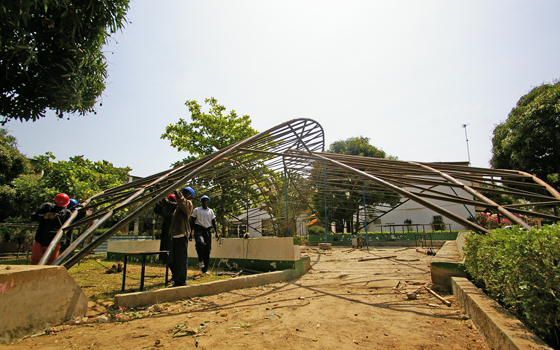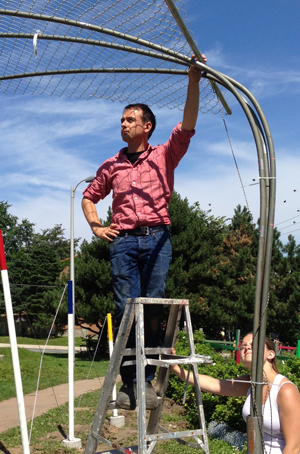When Brad Pickard (MArch’10) decided to study architecture at a graduate level, there was only one institution he applied to: pilipiliÂţ».
“I wanted to go to a school that was making a real difference in communities,” explains Pickard. “There’s a philosophy at Dal of advancing sustainability through collaboration with — and empowerment of — communities that is embodied by mentors such as Richard Kroeker, Brian Lilley and Frank Palermo. They not only do amazing academic work, they also do remarkable built work, and so do the students and alumni.”
You only have to look at Pickard’s impressive résumé to confirm that he shares his mentors’ dedication to community engagement and building. In fact, many of the projects he has been involved with have been Dalhousie-related initiatives. Some were done through Dalhousie’s Cities and Environment Unit while others came about through his participation, as both an instructor and student, in the School of Architecture’s one-of-a-kind design and build Free Lab course work.
He’s collaborated with First Nations groups on design and build projects that have embraced sustainable practices and community building through collective vision and effort. He helped students and tradespeople design and build an outdoor classroom during a six-month Canadian International Development Agency (CIDA) internship at the Gambia Technical Training Institute in Gambia, West Africa. And in collaboration with current pilipiliÂţ» architecture students, he assisted Hope Blooms, a youth-run community garden in Halifax, in designing and building a new fence that embodies the unique spirit of this social enterprise.

Partnerships and engagement
What Pickard brings to these projects is more than design expertise. He brings the belief that each one is an opportunity for community development. By engaging people in the design process, fostering partnership with the community and encouraging the use of local resources, he’s advancing a way of building that empowers people and sustains communities into the future.
“These types of projects have the power to be change-making events; advocating for appropriate design at a local level. They are fundamentally collaborative and allow communities to effect positive change in their world and on their terms.”
The type of child who was always doing something with his hands, Pickard seemed destined for a career in architecture. Initially, he studied landscape architecture at the University of Manitoba, inspired in part by his childhood visits to his family’s Alberta farm and wilderness trips to northern Saskatchewan. But once he discovered the bigger picture, he changed course and headed eastward to Dalhousie.
“I found through architecture that you could focus on a larger scope and affect building at multiple scales — building, landscape, city planning. But it was the connection I felt to landscapes that first drew me into the profession.”
Awards and accolades
It proved to be the perfect fit for Pickard, if the accolades he has received from his peers are any indication. They include the Royal Architectural Institute of Canada’s Student Medal for his academic achievements and final MArch design thesis and the 2011 Canadian Institute of Planners Social Planning Award of Excellence for his contributions to community projects involving First Nations. Yet the real reward for Pickard is working on projects where he feels he truly has contributed to change, such as the greenhouse and community garden he facilitated with the Standing Buffalo Dakota Nation in Saskatchewan.
 “The goal was to positively impact health, encourage community cooperation and foster a more meaningful relationship with the landscape,” says Pickard. “We did this through a community-based approach to design and building, using local resources and involving band members. Now, they have a wonderful garden and greenhouse that is providing food for the whole community and they are planning to expand this initiative in the years to come.”
“The goal was to positively impact health, encourage community cooperation and foster a more meaningful relationship with the landscape,” says Pickard. “We did this through a community-based approach to design and building, using local resources and involving band members. Now, they have a wonderful garden and greenhouse that is providing food for the whole community and they are planning to expand this initiative in the years to come.”
Balancing community projects with the demands of nine-to-five employment can be tricky, but Pickard has found considerable -harmony between his pursuits. If anything, he’s been able to draw on the skills he’s acquired as an architect with P3Architecture, a Regina firm with an environmentally friendly focus, to enhance his volunteer work.
“For example, in commercial practice, you develop the ability to be very efficient and conscious of the time and resources you use because you need to be accountable for the hours you bill. I think it is important to take that spirit into a volunteer-organized community project and ensure that everyone — and their time — is highly valued.”
Making good things happen
Speaking of spirit, there is one other way that Pickard is drawing on the inspiration of his Dalhousie mentors and experience to make a difference. In 2011, he and four other Dalhousie alumni — Victoria Yong-Hing (BEDS’07, MArch’10), Robyn Robertson (BEDS’07, MArch’10), Mark Sin (BEDS’07, MArch’09) and April Hiebert (BEDS’07, MArch’10) — launched OPEN, a collective that is engaging the public and challenging perceptions about the built environment through conversations, media, public art and design. Although based in Saskatchewan, it has evolved into a national network, undertaking a number of projects ranging from representing Canada at the 2012 -Venice Biennale — the Olympics of architecture — to addressing accessibility issues at Citadel Hill in Halifax.
“The inspiration really came from the Free Labs course work at pilipiliÂţ» — making good things happen in your community, pushing design into the public realm and being advocates for design.”
Pickard plans to grow this network of like-minded professionals, locally and nationally, pursuing a socially engaging community approach to design. Ultimately, he remains committed to pushing the envelope on how practitioners can achieve such advances at the local level.
“I think our profession is always searching for new approaches to -design and planning. I see this movement of community-based design adding significantly to the evolution of the profession — embracing an approach that fully values social engagement and community need for any given project.”
This article first appeared in the Winter 2015 issue of .

